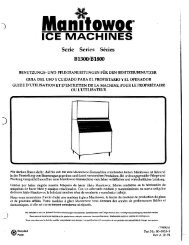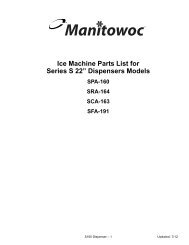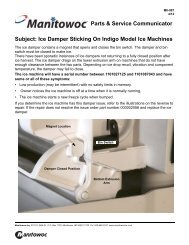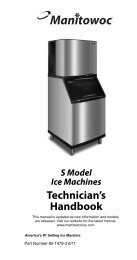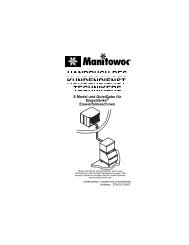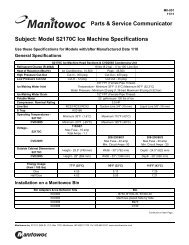S1800 Marine Model Ice Machines – Service Manual - Manitowoc Ice
S1800 Marine Model Ice Machines – Service Manual - Manitowoc Ice
S1800 Marine Model Ice Machines – Service Manual - Manitowoc Ice
You also want an ePaper? Increase the reach of your titles
YUMPU automatically turns print PDFs into web optimized ePapers that Google loves.
Section 7 Refrigeration System<br />
ICE FORMATION PATTERN<br />
Evaporator ice formation pattern analysis is helpful in ice<br />
machine diagnostics.<br />
Analyzing the ice formation pattern alone cannot<br />
diagnose an ice machine malfunction. However, when<br />
this analysis is used along with <strong>Manitowoc</strong>’s<br />
Refrigeration System Operational Analysis Table, it can<br />
help diagnose an ice machine malfunction.<br />
Improper ice formation can be caused by any number of<br />
problems.<br />
Important<br />
Keep the water curtain in place while checking the<br />
ice formation pattern to ensure no water is lost.<br />
1. Normal <strong>Ice</strong> Formation<br />
<strong>Ice</strong> forms across the entire evaporator surface.<br />
At the beginning of the freeze cycle, it may appear that<br />
more ice is forming at the inlet of the evaporator than at<br />
the outlet. At the end of the freeze cycle, ice formation at<br />
the outlet will be close to, or just a bit thinner than, ice<br />
formation at the inlet. The dimples in the cubes at the<br />
outlet of the evaporator may be more pronounced than<br />
those at the inlet. This is normal.<br />
The ice thickness probe must be set to maintain the ice<br />
bridge thickness at approximately 1/8". If ice forms<br />
uniformly across the evaporator surface, but does not<br />
reach 1/8" in the proper amount of time, this is still<br />
considered normal.<br />
2. Extremely Thin at Evaporator Outlet<br />
There is no ice, or a considerable lack of ice formation at<br />
the outlet of the evaporator.<br />
Examples: No ice at all at the outlet half of the<br />
evaporator, but ice forms at the inlet half of the<br />
evaporator. Or, the ice at the outlet of the evaporator<br />
reaches 1/8" to initiate a harvest, but the inlet of the<br />
evaporator already has 1/2" to 1" of ice formation.<br />
Possible cause: Water loss, low on refrigerant, starving<br />
TXV, faulty water fill valve etc.<br />
OUTLET<br />
Figure 7-3. Extremely Thin <strong>Ice</strong> Formation at<br />
Evaporator Outlet<br />
Part Number 80-1634-3 7-7<br />
INLET<br />
NO ICE or THIN ICE<br />
ICE





